Many people hold a particular fascination with raptors—otherwise known as birds of prey. I know I do. These big, powerful birds inspire us with their raw power, grace and majesty. So respected are these birds that they are often chosen as sports team mascots. Many countries use birds of prey as their national symbol.
The DFW Metroplex is home to a number of these mighty birds. Depending on the season, there can be as many as 20 different species of falconiformes living in the North Texas area. Some are seasonal migrants. Other are what is known as occasional vagrants—birds that sometimes roam outside their normal range. When you’re as big and powerful as a raptor soaring high in the sky, moving outside your home range is not difficult to do.
Buteos – Medium to large-sized Raptors with robust bodies and broad wings.
Perhaps the most common of all of our raptors is the Red-tailed Hawk (Buteo jamaicensis). These ubiquitous hawks are widely distributed across all of North America, and are superbly adapted to urban living. They breed readily around human populations, and often make use of man-made structures as nest locations. Urban Red-tailed Hawks can frequently be seen perched on lampposts along our highways where they stay on the look out for prey animals in the grassy medians. Red-tailed Hawks are year round residents, but their numbers increase in the winter when northern populations migrate into Texas.
The Red-tailed Hawk is a large bird with a wingspan that can approach 5 feet. The plumage displayed by this bird can vary widely depending upon age, color morph, and whether migratory subspecies are in the area. Most adult Red-tailed Hawks in the DFW area, however, display the namesake red tail, a dark band across a white breast, and light wings with a dark bar along the leading edge.
Red-tailed Hawks typically feed on small mammals such as Eastern Cottontails, Fox Squirrels, rats, and mice. Occasionally they will feed on common urban birds like feral pigeons or starlings.
More information about Red-tailed Hawks can be found here: Wikipedia – Red-tailed Hawk
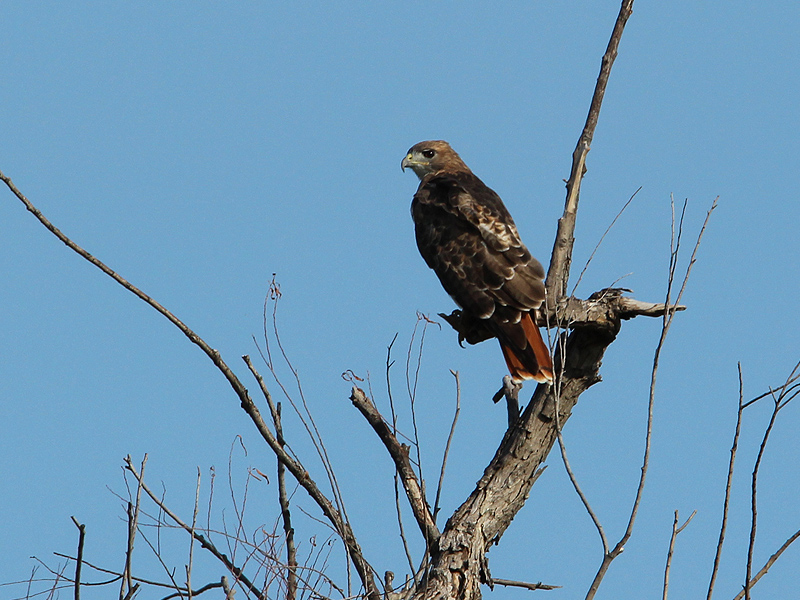
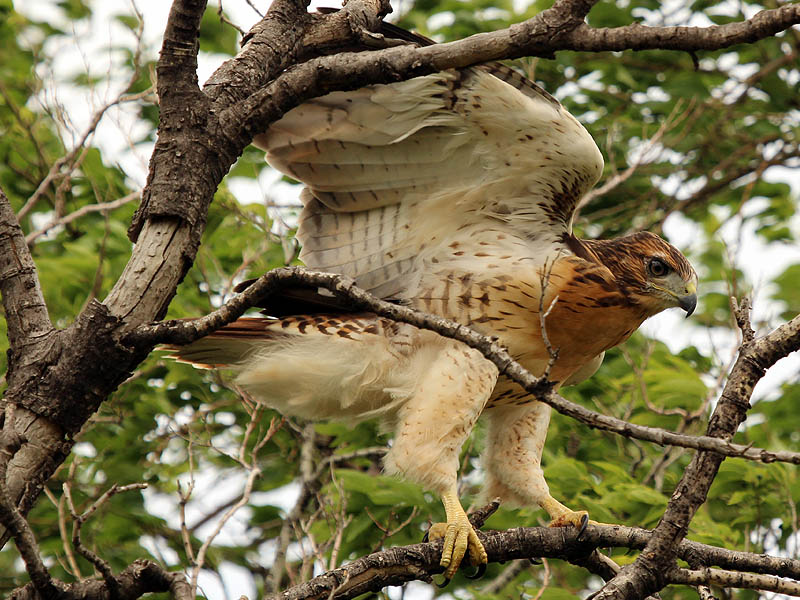
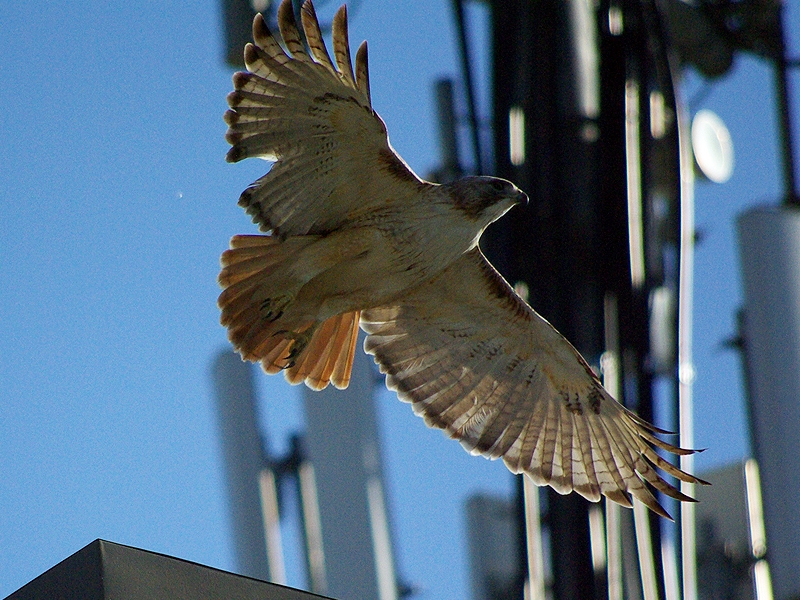
Perhaps the second most common Buteo in the metroplex is the Red-shouldered Hawk (Buteo lineatus). Although very numerous in North Texas and a year round resident, the Red-shouldered Hawk is not often seen. This is because the Red-shouldered Hawk prefers heavily wooded areas along rivers and creeks. In North Texas that means the Trinity River and its various tributaries.
These hawks breed readily in and around the metroplex, but they seldom make use of man-made structures when choosing a nesting site. Instead red-shouldered Hawks prefer to nest in tall trees located in riparian forests. Red-shouldered Hawk feed on small mammals and reptiles. Snakes are a favorite food.
The Red-shouldered Hawk is slightly smaller than the more common Red-tailed Hawk. It is easily distinguishable by its red chest and shoulders, and by its starkly black and white striped wings and tail when in flight.
More information about Red-shouldered Hawks can be found here: Wikipedia – Red-shouldered Hawk
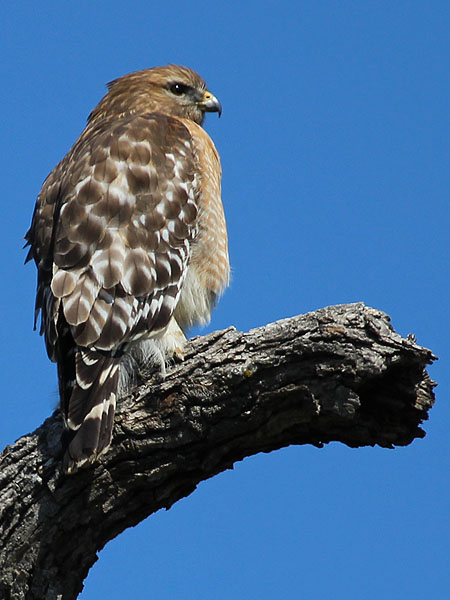
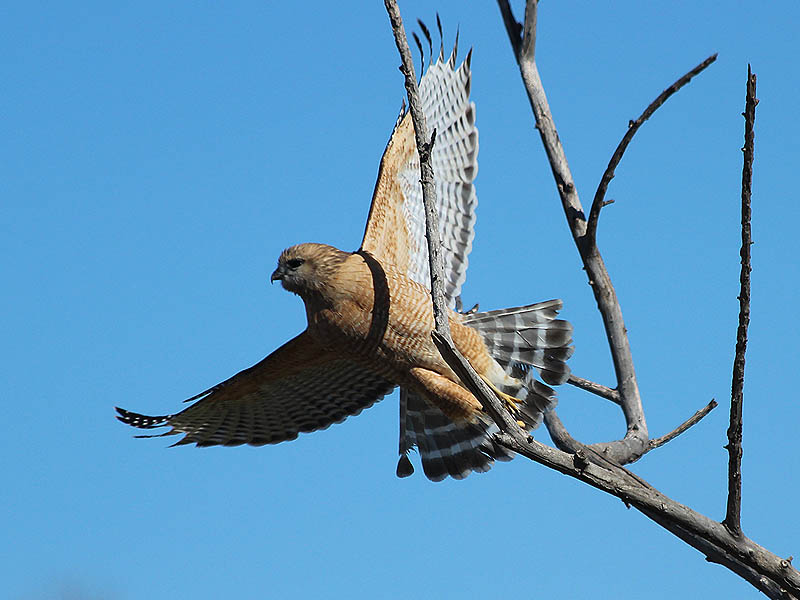
The Swainson’s Hawk (Buteo swainsoni) is another large Buteo frequently seen around the DFW Area during their migration in the fall and spring. Swainson’s Hawks spend the winter in South America, and only reach portions of the United States after a long springtime migration.
The Swainson’s Hawk is usually seen at altitude, soaring high over our urban development. In the air they are recognizable by their unique colors and configuration. Swainson’s Hawks have darkly colored heads and light undersides. Their flight feathers create a contrasting darkly colored trailing edge on their wings. In flight, the wings of these Buteos often appears narrower and more pointed that those of other similar species.
The metroplex is just at the edge of the Swainson’s Hawk beeding range, and presumably they do nest here—though I have yet to come across one of their nest. Swainson’s Hawks are much less tolerant of human activity than some of our other hawks, and therefore may nest in more rural and isolated areas.
Unusual for a hawk of this size, the diet of Swainson’s Hawk can largely consist of insects.
More information about Swainson’s Hawks can be found here: Wikipedia – Swainson’s Hawk
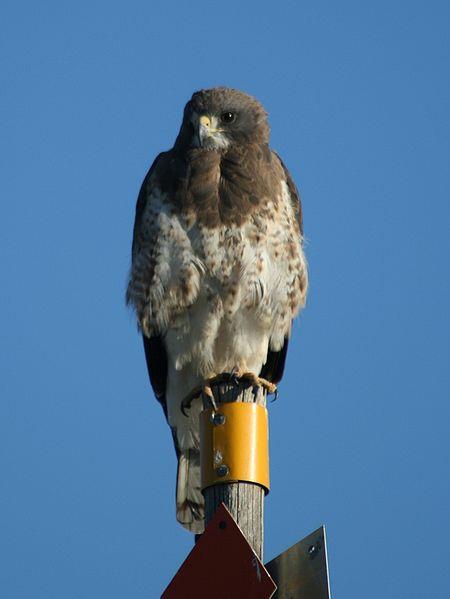
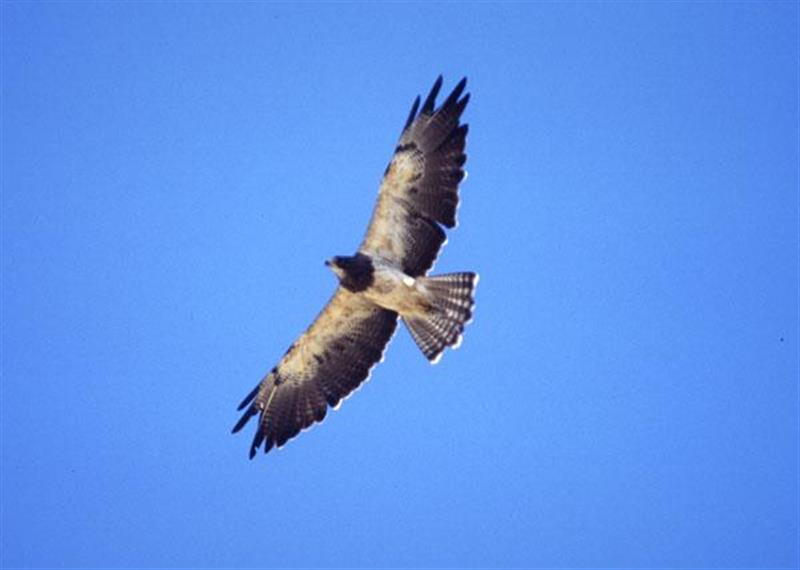
Other, less common, Buteos can be seen in the metroplex from time to time. These birds reach our area as migrants or as occasional vagrants.Though rarely seen, these hawks will be spotted by sharp-eyed birders from time to time.
The Broad-winged Hawk (Buteo platypterus) is a small hawk that is usually seen during its fall and spring migrations. At these times great kettles of Broad-wings Hawks may be seen passing high overhead as they make their way to and from South America.
Broad-winged Hawks have been know to breed in the metroplex, but Dallas/Fort Worth represents the western most limits of their summer distribution. Incidents of breeding Broad-wings Hawks increases as one travels into the eastern United States.
More information about Broad-winged Hawks can be found here: Wikipedia – Broad-winged Hawk
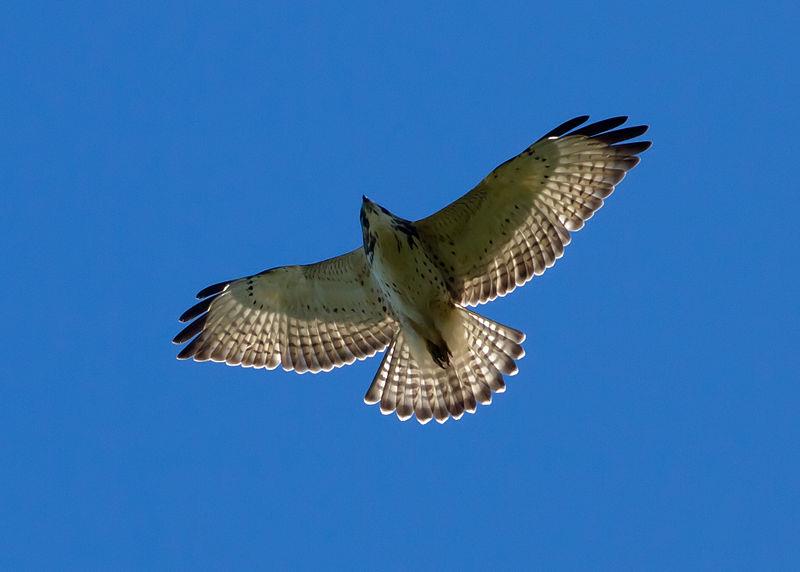

The handsome Harris Hawk (Parabuteo unicinctus) is another Buteo that occasionally makes its way to the metroplex during the winter months. These hawks are seldom seen in North Texas.
More information about Harris Hawks can be found here: Wikipedia – Harris Hawk
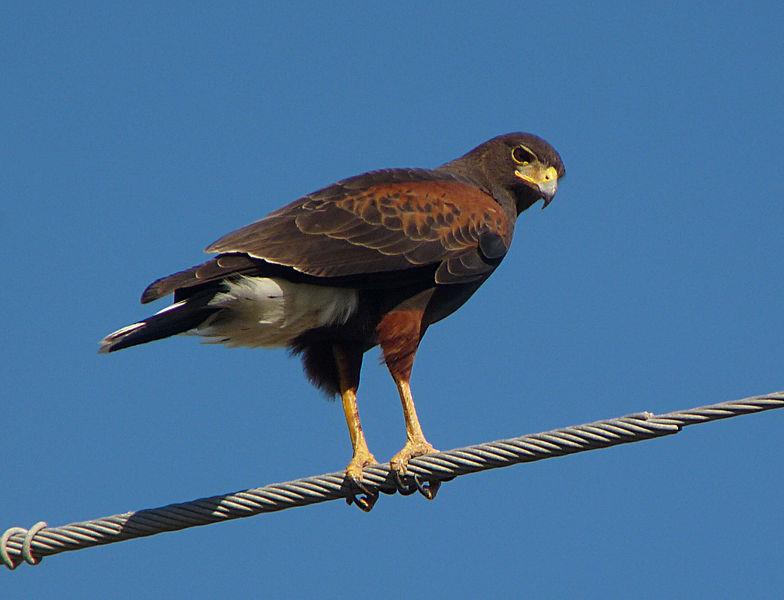
The Ferruginous Hawk (Buteo regalis) is a rare winter visitor to the metroplex. They are most likely to be be seen on prairies in our western most counties during the coldest winter months.
More information about Ferruginous Hawks can be found here: Wikipedia – Ferruginous Hawk
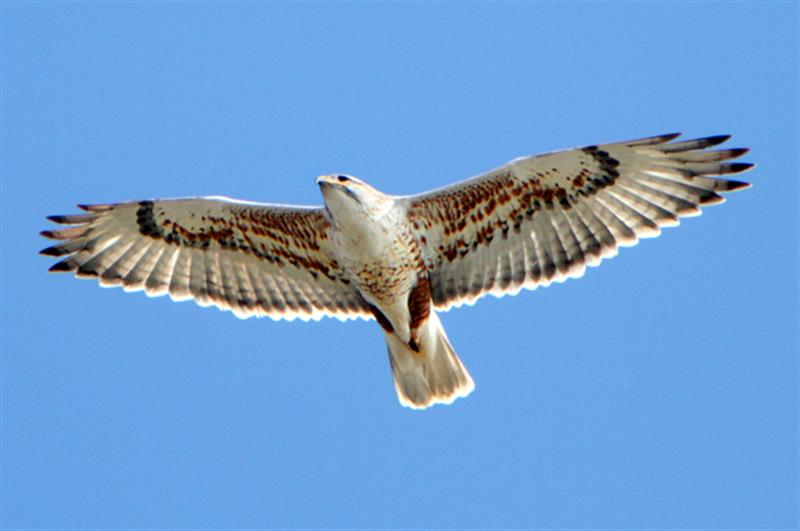

Rough-legged Hawks (Buteo lagopus) may make their way down into our northern counties during the coldest months of winter. Prairies and pastures well away from developed areas are where they are most likely to be found.
More information about Rough-legged Hawks can be found here: Wikipedia – Rough-legged Hawk

Accipiters – Woodland hawks with short wings and long tails
There are two species of Accipters to be found in the North Texas area—the Cooper’s Hawk and the Sharp-shinned Hawk. These two species are remarkably similar to each other in general apperance. Both sport nearly identical plumage coloration. Size is the primary differentiator, as the Cooper’s Hawk is usually significantly larger than the Sharp-shinned Hawk.
Of the two, the Cooper’s Hawk (Accipiter cooperii) is the most commonly observed. It is a year round resident in the DFW metroplex, and is beginning to breed more readily in our cities.
Adult Cooper’s Hawks are medium-sized raptors. They have slate gray plumage with a red and white herringbone pattern on their breast and wing leading edges. Tail and flight feather show black and white stripes when viewed from below.
Cooper’s Hawks are well adapted to hunting in wooded areas, and feed largely on other birds. A well stocked bird feeder that attracts a constant crowd of song birds might also attract a hungry Cooper’s Hawk to your backyard as well.
More information about Cooper’s Hawks can be found here: Wikipedia – Cooper’s Hawk
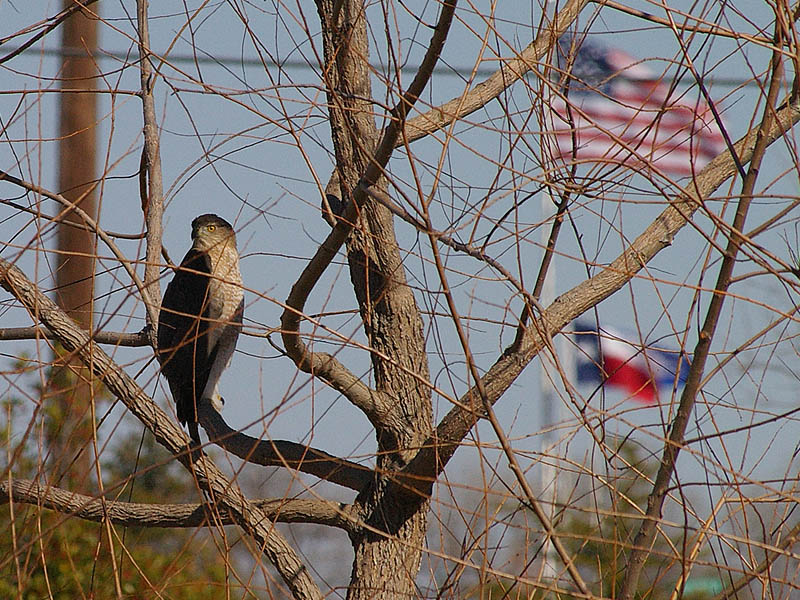
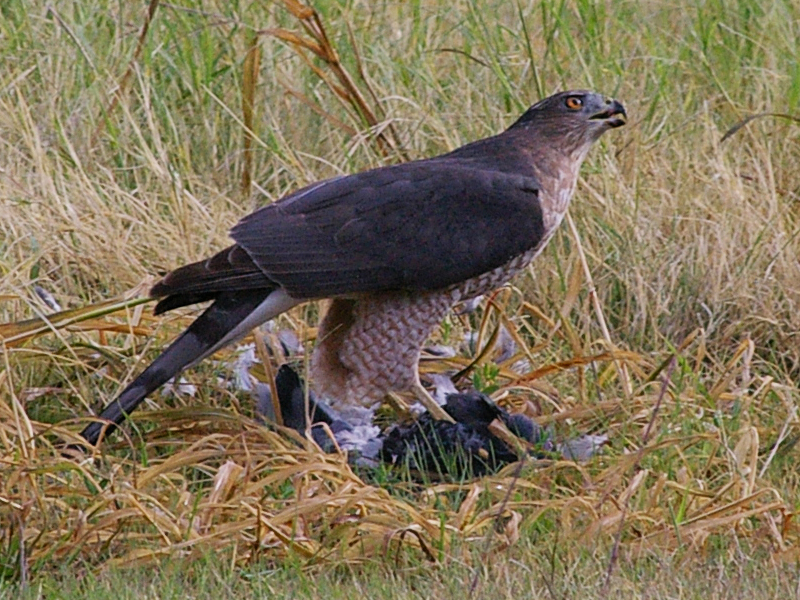
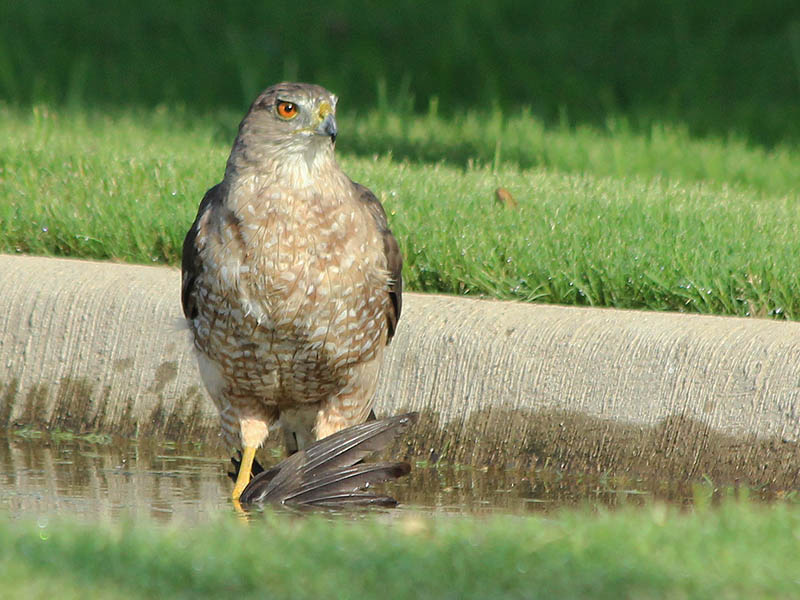

The smaller Sharped-shinned Hawk (Accipiter striatus) is very similar in appearance to the Copper’s Hawk. Key differences include a shorter, square cut tail, and a large-eyed, more gentle appearance about the face. Sharp-shinned Hawks are in the DFW Area only in the winter months.
Like the Cooper’s Hawk, Sharp-shinned Hawks are well adapted to woodland hunting a preferred to feed on small birds.
More information about Sharp-shinned Hawks can be found here: Wikipedia – Sharp-shinned Hawk
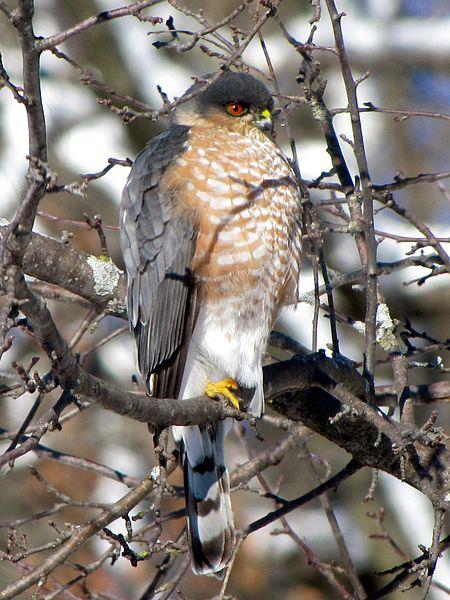
Falcons – Sleek aerobatic raptors with long pointed wings
The most common falcon in the Dallas/Fort Worth Metroplex is the American Kestrel (Falco sparverius). This small, Blue Jay-sized raptor can frequently be seen perched on utility wires overlooking open fields and vacant lots. The American Kestrel is a strikingly beautiful bird with a multicolored plumage that includes slate gray, yellow, orange, black, and white. The male of the species is particularly exotic looking.
These birds are year round residents in North Texas and breed readily in urban areas. They are cavity nesters and will make use of man made structures near suitable hunting grounds for their nesting needs.
The diet of the American Kestrel consist largely of insects, but they will also feed on small mammals, birds, and reptiles.
More information about American Kestrels can be found here: Wikipedia – American Kestrel


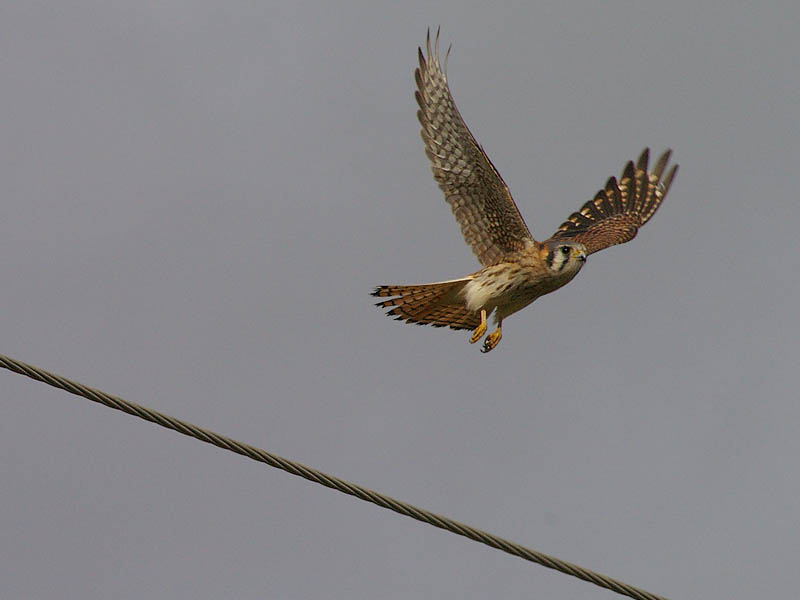
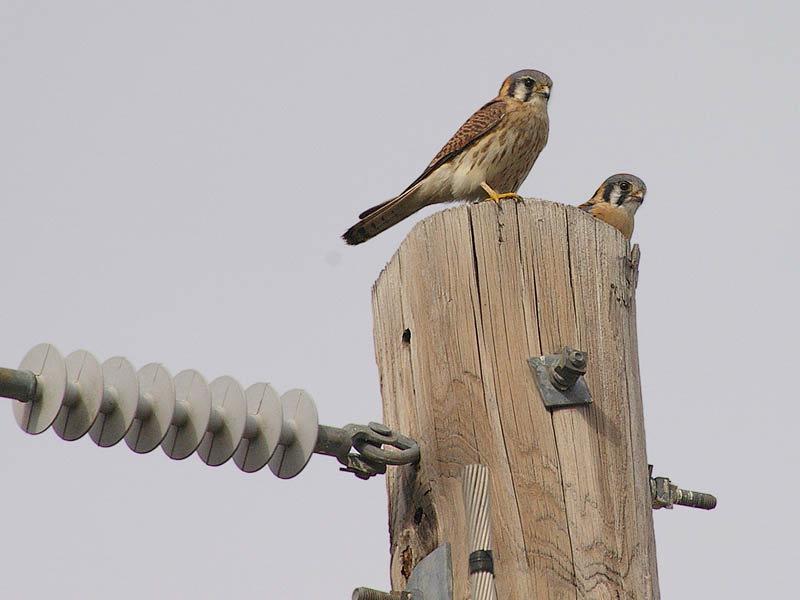
The Merlin (Falco columbarius) is also sometimes seen in the metroplex. These small falcons—only slightly larger than the American Kestrel—can be found in North Texas during the winter months, and may be more evident during the fall and spring migrations.
More information about Merlins can be found here: Wikipedia – Merlin

A few other species of falcon may sometimes wander into the metroplex. The Prairie Falcon (Falco mexicanus) is a rare winter visitor. It is typically only seen in our western most counties.
More information about Prairie Falcons can be found here: Wikipedia – Prairie Falcon
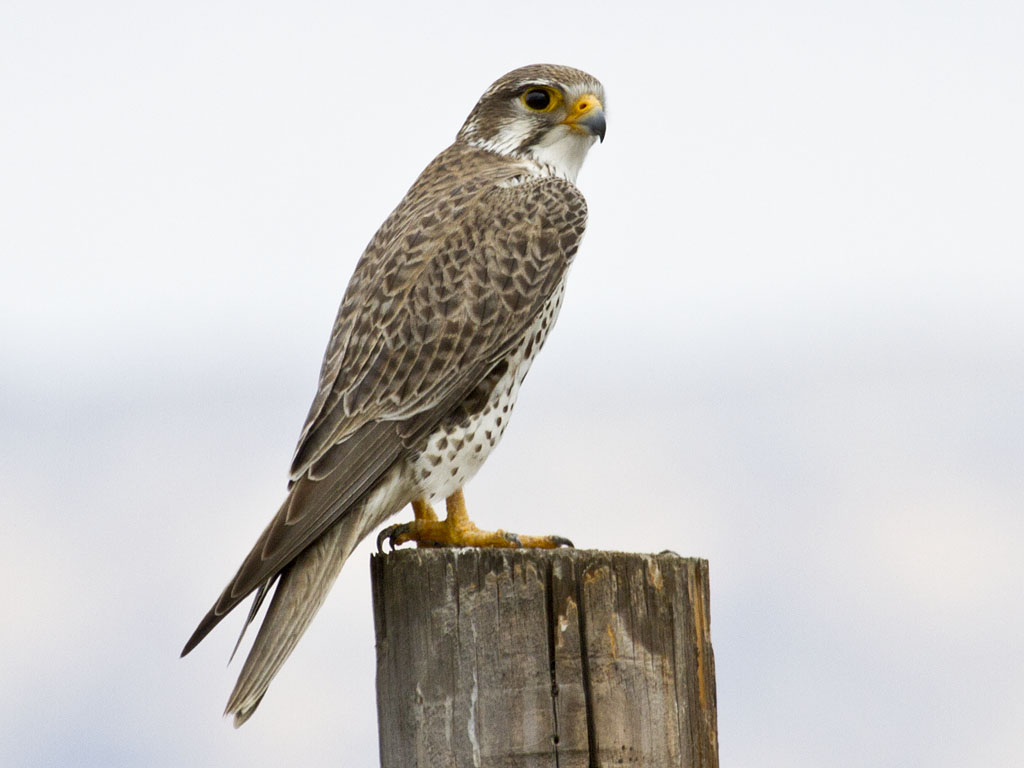
The well know Peregrine Falcon (Falco peregrinus) also makes it into the metroplex from time to time. A rarely seen vagrant, Peregrine Falcons are only likely to be seen during their fall and spring migrations.
More information about Peregrine Falcons can be found here: Wikipedia – Peregrine Falcon

Kites – Small raptors known for their graceful flight
The Mississippi Kite (Ictinia mississippiensis) is the most commonly seen kite in North Texas. These uniformly gray birds are the raptor world’s analog to an Air Force fighter jet.
The breeding range of Mississippi Kites has only recently expanded into North Texas. They now readily nest here, preferring bottomland forests near rivers and creeks for their breeding grounds. They are locally abundant in some places and large congregations may form in late summer as their young begin to leave the nest.
These birds feed primarily upon insects like dragonflies and grasshoppers, and they can frequently be seen feeding while in flight.
More information about Mississippi Kites can be found here: Wikipedia – Mississippi Kite
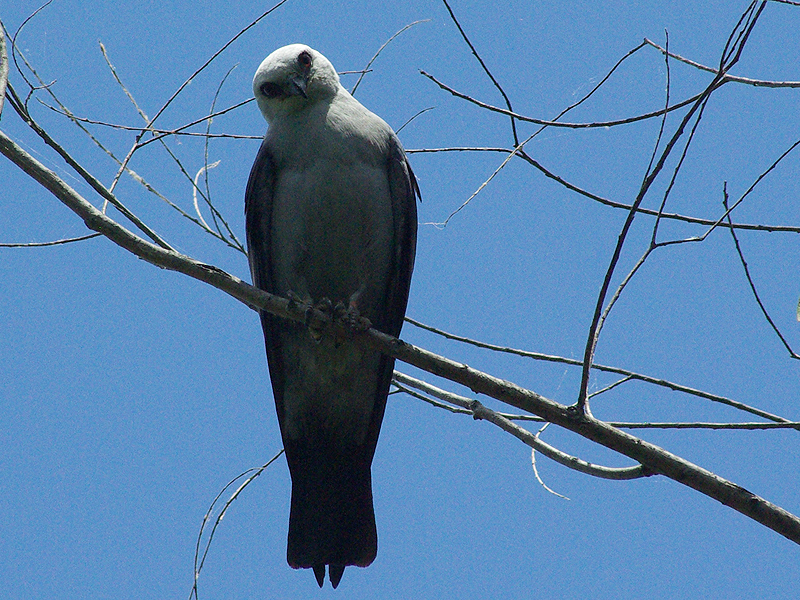
Seeing a Swallow-tailed Kite (Elanoides forficatus) in the metroplex is an exciting occasion. They are seldom seen here, but they seem to be expanding their range, and may even be breeding in certain areas in our most southeastern counties. Swallow-tailed Kites are beautiful raptors dressed in a plumages of white, gray, and black feathers. The Swallow-tailed Kite’s most notable trait is long forked “swallow tail”. Only slightly larger than the more common Mississippi Kite, the Swallow-tailed Kite is unmistakable for anything else when seen in flight.
More information about Swallow-tailed Kites can be found here: Wikipedia – Swallow-tailed Kite

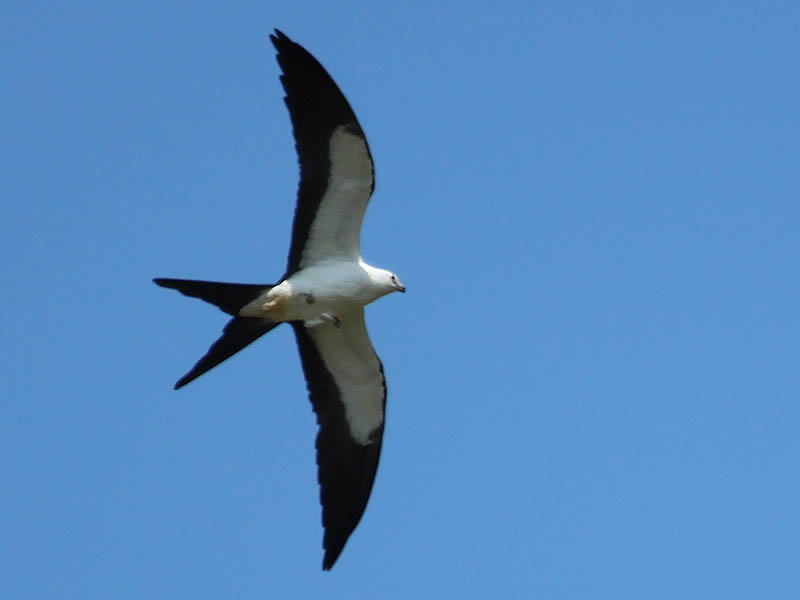
White-tailed Kites (Elanus leucurus) are almost never seen in the DFW Metroplex. Year round populations exist in far south Texas. Occasionally one will make it way into the metroplex. In 2013 a White-tailed Kite was photographed in North Texas near Lewisville Lake. You can read about that account on this Facebook page: White-tailed Kite at LLELA Lewisville Lake.
More information about White-tailed Kites can be found here: Wikipedia – White-tailed Kite


Eagles – Large, powerfully built birds of prey
When it comes to raptors the Bald Eagle (Haliaeetus leucocephalus) may be the first bird to come to mind for most people in the United States. Our national symbol, the Bald Eagle has a power and grace that is nothing short of awe inspiring. These large birds of prey are uniformly dark brown in color except for their distinctive white heads and tails. Bright yellow beaks, eyes, and talons round out the Bald Eagle’s distinctive appearance. Juveniles sport a blotchy brown plumage and take up to five years to develop the more familiar look of the adult birds.
Bald Eagles have recently been removed from the endangered species list. The are becoming more abundance and they are expanding their range. Bald Eagles can frequently be seen in the Dallas/Fort Worth area, especially in the winter when many migratory eagles arrive in North Texas. These eagles feed primarily on fish and water fowl, making area lakes and rivers great places to try and see one. We even have some year round resident eagles in the metroplex, and a few breeding pairs. Some of theses eagles finding new ways to adapt to the presence of people.
More information about Bald Eagles can be found here: Wikipedia – Bald Eagle
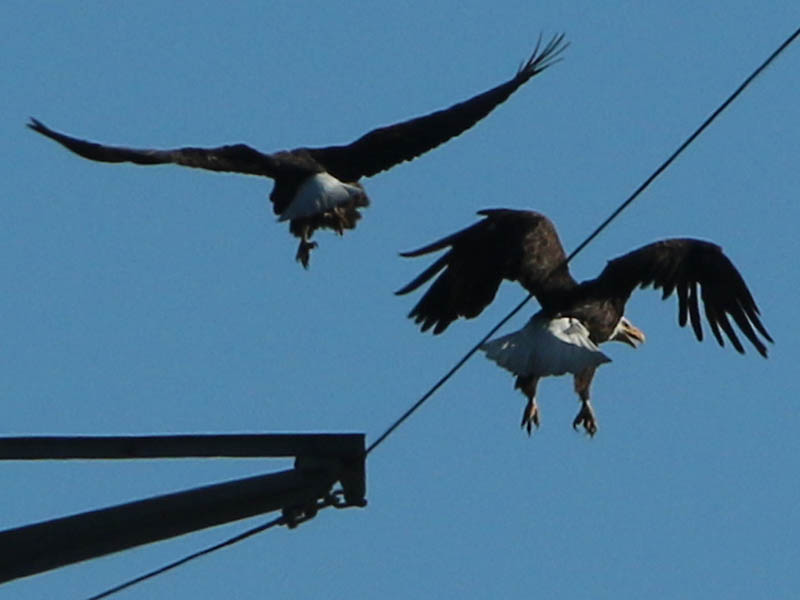


The Golden Eagle (Aquila chrysaetos) will not be frequently seen in the North Texas area. This powerful bird of prey is native to the western most part of the continent, and may only occasionally roam into the DFW Metroplex in the winter. Adult birds can somewhat resemble juvenile Bald Eagles, so great care must be taken when identifying this rare vagrant.
More information about Golden Eagles can be found here: Wikipedia – Golden Eagle

Others – Caracaras, Ospreys, and Harriers
Crested Caracaras (Caracara cheriway) are very distinctive looking birds. The caracara is covered in a dark plumage. Its head is colored white with a dark crown. Wing tips and tail feathers are white with fine black striping. The caracara’s legs are long and yellow, and its beak is a pale red tipped with gray. They superficially resemble Bald Eagles and can be mistaken as such under certain viewing conditions.
The Crested Caracaras is becoming more common in the metroplex, as native populations in the south expand their range. Our southern counties provide the best opportunity for seeing a Crested Caracara.
These birds will feed on carrion and can often be found congregating with Black Vultures and Turkey Vultures around the carcass of a dead animal.
More information about Crested Caracaras can be found here: Wikipedia – Crested Caracara
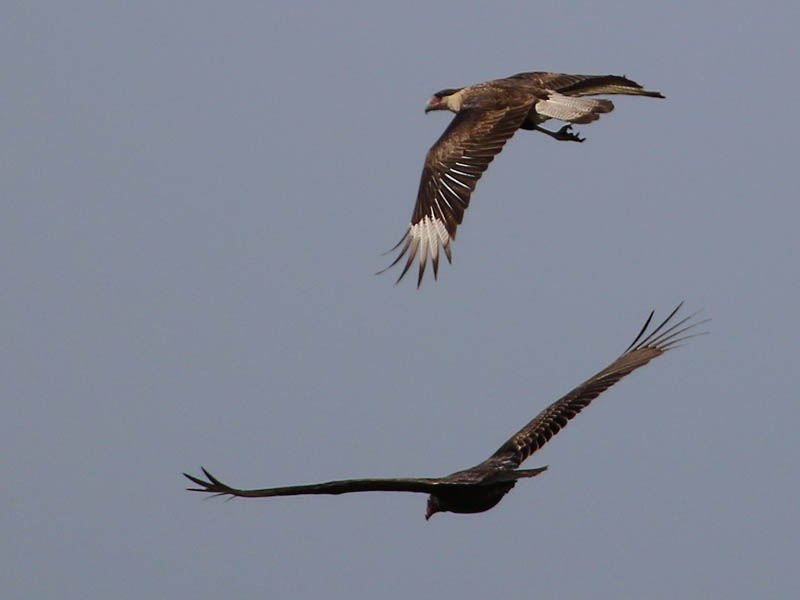

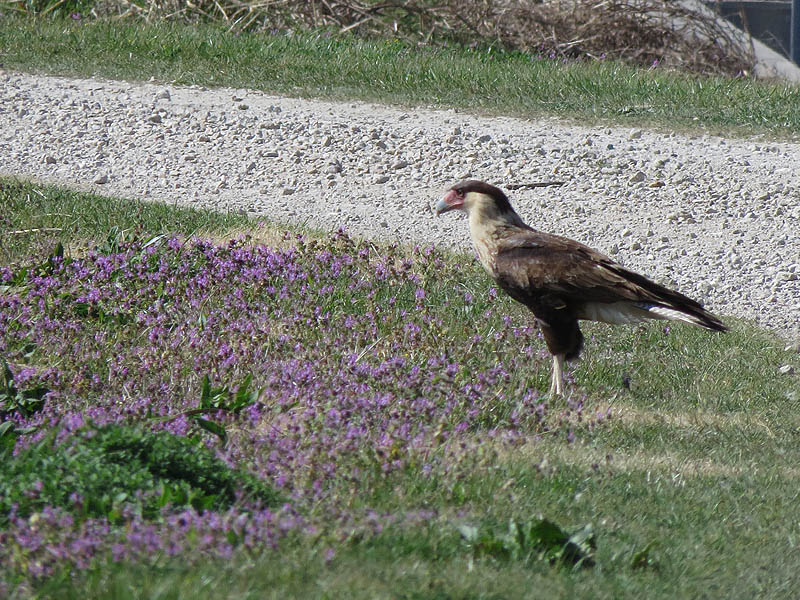
Osprey (Pandion haliaetus) are superbly adapted for catching fish. This large raptor also goes by the names sea hawk, fish eagle, river hawk, or fish hawk. These birds become common in the winter around our larger lakes and rivers as northern populations migrate south. We even have a small resident population that can be found in certain locations year round.
As you might suspect, the Osprey’s diet consist almost exclusively of fish. These birds have several special adapations to help them catch fish—long curved talons being the most obvious of these. Further, the Osprey’s outer toe is reversible, which allows these raptors to grasp their slippery prey with two toes in the front and two in the back.
More information about Ospreys can be found here: Wikipedia – Osprey
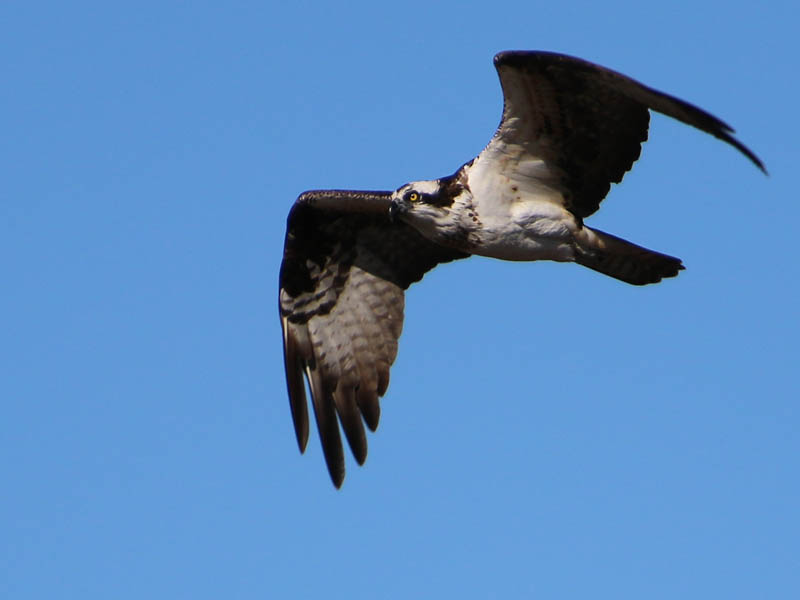
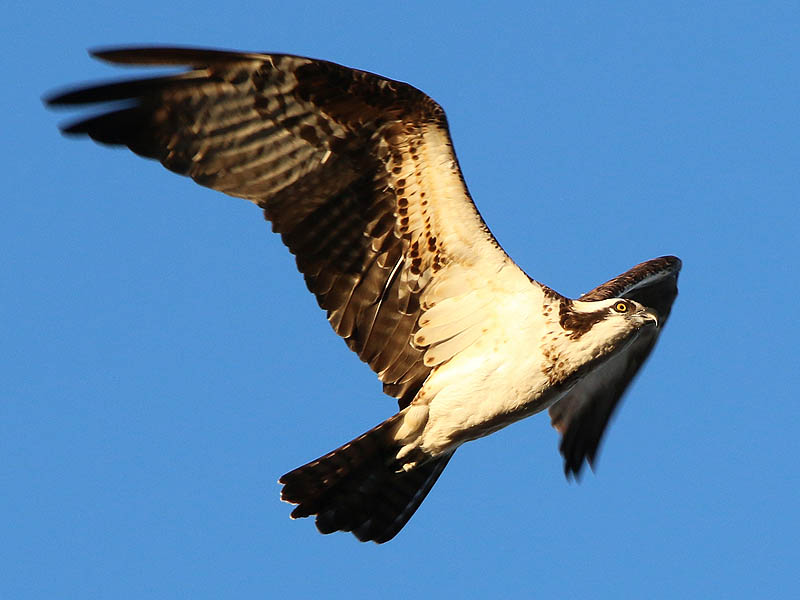

Northern Harriers are unique raptors with the body of a hawk or falcon and dish-shaped face of owl. Northern Harriers make their way into North Texas during the winter months. Once here they can often be seen hunting low over marshy wetland areas. Harriers feed on any small animal that might be found in habitats like these. Small mammals, birds, reptiles, and amphibians are all likely prey for the Northern Harrier.
Males and females of these medium-sized raptors differ in appearance. Females are brown with light undersides. Males also have lightly colored undersides but are slate gray on top and have dark wing tips. Both males and females sport a distinctive white stripe at the base of their tail that is an unmistakeable identifier. Both sexes also have an owlish face which is thought to help funnel sounds to their ears to help them pinpoint prey animals hidden beneath vegetation.
More information about Northern Harriers can be found here: Wikipedia – Northern Harrier
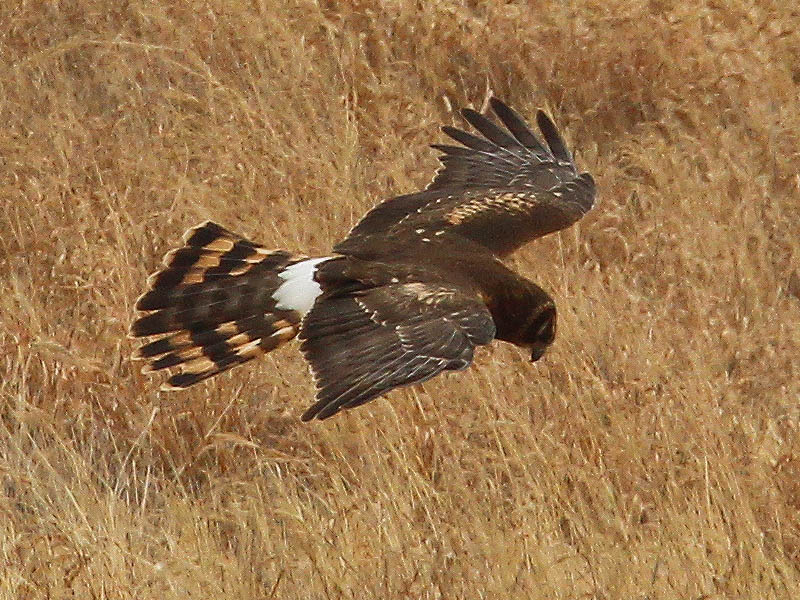
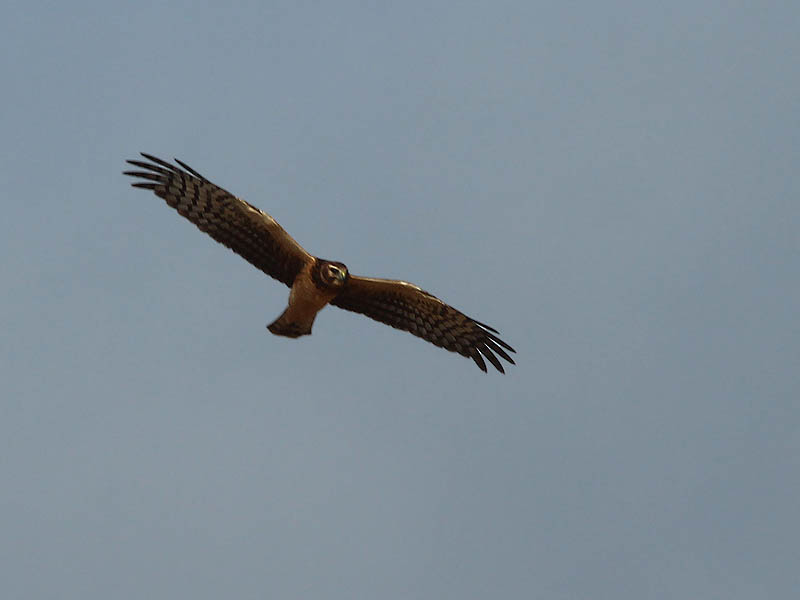





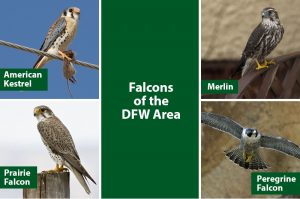
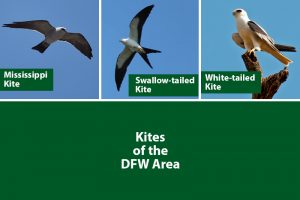





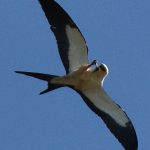
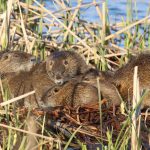
I really enjoyed your article about the big birds that fly in and around the Dallas-Fort Worth area. I had no idea there so many varieties in my area. I live in Dallas.
do you know if there are any rescues or something similar in DFW or Texas where you can handle some of these birds?
Rogers Wildlife Rehabilitation Center in Hutchins handles raptors. Here’s the web address: http://www.rogerswildlife.org
Blackland Prairie Raptor Center
469-964-9696
http://www.bpraptorcenter.org/
I’ve heard and seen many of the hawks in the area…including Preston Hollow and Park Central. Neat to see them!
Great site! I have a nesting pair of Kites by my house, by the creek. They have been here for the past 3 years. I think they are the White Tail Kites, I’ve listen to recorded sounds and seen a lot of different pictures. Is there any definite, distinguishing identifiers to differentiate between the 3 types of Kites you have listed? I live in Decater, Wise county, Tx. About 40 min NW of Fort Worth. Thx!
White-tailed Kites pass through occasionally, but it is unlikely that they would be breeding here. Most likely you have Mississippi Kites, which are very numerous in North Texas. An easy way to differentiate the two would be by looking at the tail of an adult bird while in flight. If it is darkly colored, then you have a Mississippi Kite. If it is white, you have a White-tailed Kite. Either way, I am curious to hear what you determine. I hope you’ll come back on and share your findings with us!
Thanks!
Chris
I also live in Decatur and have some hawks by my house. Just not sure what kind they are. The one I see the most is light grey color
Underneath
Those are almost certainly Mississippi Kites, Mark. It’s been a banner year for MIKIs in the metroplex this season!
As I’m watching them fly around right now, their tails are defiantly dark! The Mississippi Kites are so beautiful! Thank you so much, I hope get my daughter’s high powered camera and take a few pics!
MIKIs are some of my favorite birds!
For the last few weeks, about six of these birds soars around the area every morning. They have a mostly white head and the top of their wing is mostly white. They are about the size of a hawk but I have not been able to identify them. Also, since they soar around about the same time every morning, could someone raise them and keep them as sort of pets and allow them to exercise occasionally. I don’t recall seeing these birds and have lived here 40 years.
Sounds like Mississippi Kites… not pets. The number of kites in the metroplex may be increasing year after year!
I’m trying to find out which of the birds my dad and I rescued this morning from his garden. It was a very beautiful bird and I’m guessing it was a hawk of some kind. I snapped a photo of it as well.
I am trying to identify a hawk which we had a very good look at sitting on bird pond in our garden. A beautiful light brown color with a lot of white on cheeks slightly darker brown on top of head. No stripes or flecks on chest which was almost white. Very dark stripes on tail widly spaced and white on end. Light beek and yellow feet. At least 18 inches tall. I have looked at photos of Ccooper Hawks. Not the same. This bird was a warm reddish tan and chest cream colored.
Will be hard to say with certainty without pictures, Ashford.
Maybe a Harris Hawk?
I recently saw a large group of Northern Harriers just south of the Red River. They were hunting over a field that was being disced and harrowed. I did two counts. One was while they were flying and later on in the evening, many of them landed in our horse pasture so I counted them again. While they were flying I counted 40 and while they were perched or on the ground, I counted 35 but I’m sure I didn’t find them all. Some were hanging out in the field and I couldn’t see them very well. I was lucky enough to have my camera with a 600 mm lens and was fortunate enough to get a lot of great pictures and many more bad ones ;). I also took some very shaky video of them sitting in the pasture (that 600mm lens is heavy and I didn’t have my tripod). Is it unusual to see this many hunting at one time? I’ve never seen that before and figure I’ll never live to see it again. From what I’ve read it is not normal for them to migrate in groups this large. Could they have a nesting colony near here?
This sounds unusual for harriers… I would love to see some of your pictures. If you would like to email me a few, you can use the “Contact Us” button on the right-hand side of this page near the top.
Seen this too but during migration.. piles of NOHA sweeping over fields up near Pampa circa 2012-3. I’d have to look back at my notes but it was probably >20 individuals. Beautiful photos in this blog.
Jeanette shared her pictures with me, and it turns out that it was migrating Swainson’s Hawks that she saw! Excellent!
Thanks so much for your help with the ID!
We had to Caracara’s in our yard this week. What a beautiful bird. Took pictures. Never have seen them before. We live in Ellis county. Just a little west of Waxahachie.
We have three Hawks in our backyard right now – all together – one with a long white tail feathers
Do they usually stay together in groups?
It sounds like you have some juveniles—siblings. If one looks different than the other, it may be one of the parents.
Saw a Mississippi Kite today (07/03/16) in my neighborhood in Denton, TX, selecting twigs from one of my dead post oaks, most likely for a nearby nest he and a mate are building. Have been seeing him since early May flying and circling in the neighborhood, but this was the first chance I could get a good look to ID him. We have five dead post oaks and he seems to like them a great deal for hunting and for nest materials.
I live on 2 acres on the South side of College Station, Texas. Last week a hawk buzzed me on 2 separate occasions. Today I walked out back and was hit in the top of my head by this hawk. It does not appear to be a large hawk. However, it is very aggressive. I am now going out back with my shot gun. Any idea of this type of hawk.
Mike Higgins
This is a Cooper’s Hawk that has young offspring nearby. They are learning to fly and they are very vulnerable right now. That is what is making the hawk behave aggressively toward you… she is being protective of her young. There maybe up to four or five fledglings. Please do not shoot this hawk, the juveniles will depend on her for several more weeks. Not to mention that it is extremely illegal to kill Hawks in Texas.
I believe I have a pair of Mississippi kites in my back property, however when in flight I can see round black dots under their wings. Is this still a kite or something else?
I cannot say from your description, Ryan. Round black dots underwing does not really describe Mississippi Kites. The problem is that it doesn’t really describe any other bird that I can think of either. Maybe you are seeing barring and interpreting it as dots? You might start by googling for images of juvenile Mississippi kites in flight to see if they match what you saw. You could compare to images of Red-shouldered Hawks in flight too.
We have Mississippi Kites nesting in our neighborhood in Burleson. Love to whistle to them and call them in.
Thank you for these great pictures – we have a Kestrel outside our office windows today – we are on the 7th floor in Richardson
Hey Y’all! I’m a certified know-nothing when it comes to birds and i was hoping to get an identification on possibly the biggest bird I’ve ever seen in person. I walk my dog daily in Highland Park. I see a lot of Hawks and tons of Ducks but nothing like what i saw today. With a fresh kill in its talons, I was simply shocked at the size of the Eagle? Hawk? Golden breasted and beaked with white feathers scattered on brown wings and tail.. Had to be 3 ft tall but in flight the wings were massive. Never have i been so mesmerized. Thanks for any help! This is probably no big deal to you folks…lol.
I hate to be that guy but i have no idea how to post pictures on this site. Any help would be appreciated.
I have been visited by one kite for months only to find out this morning it’s two of them…I am in awe of them.
I live on wooded cliff along the banks of Lake Granbury. I have may birds that visit often, but I was rather startled last week when a slender yellow-legged falcon landed in a low branch about six feet from my window. I did have the presence to photograph the bird as it sat in the tree. I just knew it was a falcon having seen exhibition falconers work their birds. I took my photos to the internet to find out which breed had blessed my with his (or her) visit. I narrowed the choices down to either a Aplomado Falcon or a Peregrine Falcon. Since my bird had no white eyebrow, it was clear, at least to me, that I had seen a rare Peregrine Falcon. The bird moved off in a tree about 20 yards away and groomed his feathers. That was also quite a treat. I hope to see him (or her) again. I would be more that happy to forward the photos.
We have some sort of hawk, who’s discovered we have Roy dogs. I want to purchase one of those fake owls to perch on my roof. Do you know where I can find one please?
We spotted a bald eagle at the west end of Lake Grapevine yesterday morning. It’s the. A meager west of where Denton Creek feeds into the lake. The water is 3-5′ deep in this area. He Circle an area and caught a fish. We have a picture through our scope of him as he had just finished his meal. Beautiful bird!
Not sure how to send a picture though?
There are several ways you can share your picture…
You can email them to contact at dfwurbanwildlife.com,
or you could share it on our Facebook group: https://www.facebook.com/groups/726012804182335/
or you could post it on our iNaturalist project: http://www.inaturalist.org/projects/dfw-urban-wildlife
We would like to see it!
A pair of White Tailed Kites have been spotted in my neighborhood in Plano (Coit and Legacy) May 19, 2017. Beautiful birds, and a first for me!
Last summer I had a juvenile male Northern Harrier attack my caged Monk Parakeet and kill her.
I have many big trees and dogs in my backyard, so I was completely shocked to look out the window and see this happening. They don’t ALWAYS just fly low over fields to find prey…they are very lazy and look for the easiest possible meal.
Oops..I meant to post the location: Weatherford, Texas
Pair of Prairie Falcons hanging out at my son-in-law’s house in McKinney. Been here several days to couple of weeks
Wow, just got an up close look at what I guess is a migrating peregrine falcon – 6 feet from me, out my kitchen window, as it dive bombed my bird feeder! My little birds scattered, and the empty handed falcon sat on the gutter, contemplating his next move, before making a swoop across my front yard and away. I haven’t seen a peregrine since I moved to Texas decades ago. Breathtaking movement and beauty! Didn’t realize they sometimes migrate through Metroplex.
For last 3 weeks have noticed daily large numbers of small hawks (much smaller than red tail) circling in the SW corner of FtWorth. Moving generally south or north. Small, thin, very aerodynamic wings (no apparent ruffles), broad tails, generally flying at 100 to 200 feet. Usually two to four at one time, but dozens throughout the week. Any idea of this variety? Thanks.
Sounds like Mississippi Kites.
On 10/1/27 on FM455 between Sanger and Slidell in Northwest Denton County I saw a hawk with a WHITE broad fan-like tail flying low across the road. Dark grey plummage on top of the body. It was a good sized hawk (about like a Red Shouldered). Any ideas what it could be? The prominent white fan tail looked like a Bald Eagle but it was too small to be a Bald Eagle.
Coolest thing I love in wise county and saw my first half egale today didn’t know they where here
Thank you for sharing, great information!
Today I was on a trip from Central Texas to Denton. Saw 10-12 Hawks. My daughter said most were red tail. They were along i-35 in lamp posts, exit signs, trees, power poles. I’m no expert of any kind but it was definitely interesting to see so many.
Lots of hawks in North Texas during the winter. Most will be Red-tailed Hawks. The hunting is good in the short grass along the highways!
This is the second year that a pair of Red Shouldered Hawks have nested in one of my tall pine trees. The tree they chose is not 20 feet from the house. And again, they have three fledglings. I’m concerned, however, because I’ve not seen the male in several days. Two days ago, my son brought over a fresh road-kill squirrel. I laid it on a rock and, as before when I’ve found extra meat, the female swooped down. It was too heavy for her to carry, although she tried, finally she just sat with the squirrel in her talons calling for her mate. She did this repeatedly for some minutes. He never showed, and still has not. She ate part of it, but still it was too heavy for her to do more than hop a few feet. I cut the legs off, laid them on the rock and she took them to the fledglings.
My question to anyone who knows Hawks, is, what will happen to her and the babies if he does not return? Will she be able to teach them to fly by herself? Will she mate again?
Thanks for any advise.
Something may have happened to her mate. If so, things will be more challenging for her and the young. But if the young are old enough to fledge the mother will be able to spend more time away from the nest in order to hunt. The young will learn to fly without assistance from the adult male. The adult female will certainly mate again. She may or may not reuse this nest again.
This article is so helpful!! Thank you so much for providing such detailed information to help with bird identification!
Hello! I’ve found this article after searching for hawks that live in the DFW metro area. I live in Bedford and I regularly see 3 juvenile hawks flying together at different altitudes over my neighborhood just west of the Bedford Boys Ranch. I’ve seen all 3 perched on the fence in back of Shady Brook Elementary too so maybe they nest in the area. I’m curious as to what kind of hawk they are? They are beautiful to watch soaring on the air currents. I’ve noticed that when they are overhead I often find doves in my yard who refuse to fly unless my dog or I get within a few feet of them. I’m sure it’s fear of the hawks!
We are having an infestation of crickets in the buildings where I work near MacArthur High School in Irving. Yesterday evening I was watching about 6 birds that would sit in the oak trees then swoop across the empty parking lot, snatch a cricket and seem to eat it while flying, then land in a tree again. I’m guessing it was a Mississippi kite. I have video but it isn’t terribly clear. Any chance you could identify?
I saw 10-15 medium sized raptors over southern Denton this morning. I got a great picture of one as it swooped near me. Any chance you could identify the bird? Have a video of the group circling around as well.
Sounds like Mississippi Kites!
I live in San Antonio, a mostly suburban area. A hawk took down a white-wing dove in my backyard this past Sunday (23 Sep).Not sure about the type–leaning towards a Coopers. Heard a thump on the house and there they were. I watched the hawk pin the dove, and was jumping on it-I suppose to finish it off. Later on I looked-nothing there but a pile of feathers. Yes, the doves did clear out; this morning is the first I saw any, and they were Mourning Doves.
I walk my dogs at Eastfield College in Mesquite and the hawks there always come in at this time of year. Not sure about which ones they are. I saw about 7 today. I really enjoy seeing them fly and the sounds they make when they sit on the light posts.
I live in Bosque county and have twice spotted a bird that looks very similar to a bald eagle with a white head and tail. The most recent spotting was yesterday. On this particular bird, I noticed on the top side of its wings it had a large white spot. It looks just like a bald eagle, but I was not sure they would have white spots on their wings. Could you offer any help? Thank you!
What do you think about the Crested Caracara?
https://www.allaboutbirds.org/guide/Crested_Caracara/id
Yes! I spotted a crested caracara near lake Lewisville and told my buddy as it flew towards us “LOOK A BALD EAGLE!!” As it went over our heads it lit in a residential tree about 50 yards away. I ran closer for a better look and realized it wasn’t a bald eagle so I jumped straight into researching birds of prey and found it was the caracara! They look a lot like a bald eagle from a distance with the white head and dark body but that bright ORANGE bill gave him away once I got a closer look.
We’ve got a Cooper hawk with the vertical chest markings that make me think it’s a juvenile. It’s not real large either. It’s got a call and response going with another bird.
It’s mid July, is it mating behavior or calling to a sibling?
If its a juvenile, it may be calling to its parents, wanting to be fed.
I saw what looks like a Mississippi Kite perched in a tree next to our house in Plano near Legacy and Independence. It has a white head with round eyes with black around them and it has a white breast and grey wings. We don’t see many raptors or hawks in our neighborhood so it was exciting to see one.
I just saw the largest hawk I have ever seen on the cotton wood creek trail by 75 and Forest Ln yesterday in Dallas TX this Bird looked like it was almost 2 ft tall
I grew up next to the bald eagle nest in Kaufman county. They nested in the town of Combine between Seagoville and Crandall. They nested in a massive power line tower and the power company was concerned about it so they created a duplicate tower with no power lines and installed it and moved the nest while the eagles were gone for the season. They also mounted a camera to watch the eagles on a website and waited for them to return the following season and what do ya know they made the transition into the new tower designated for them! A beautiful thing! They said the female circled the old tower (with power lines in it) and began dropping sticks to rebuild her nest for a while until she noticed her old nest and eventually took it back over in her own designated tower. Now I am in Dallas and I saw a created caracara near lake Lewisville and I frequently go around Eastfield College and see what I believe are prairie falcons! Love this page and the comments!
I have a behavior I’d like to report. Several years ago, I was driving south of Weatherford, exploring. I stopped my truck to watch an aerial battle. A raptor, possibly red-tail, was being harassed by two smaller birds. Finally the raptor, apparently having enough, turned away from the strand of trees the bird couple were protecting and started flying away to the right and away from me. The bird couple continued to harass the raptor. One of the little birds actually landed on the raptor’s back. I was truly impressed with what I just witnessed. As I put my truck into gear, my vision was caught by movement in the trees to the left. What I saw was a second raptor flying very swiftly through the trees at a low altitude. It got to one tree and flew straight up, disappearing into the foliage of the tree. Now I was stunned. I had never heard of such a cooperative hunting strategy in this area let alone witnessing one. Is this an anomaly?
What you observed was a behavior known as “mobbing.” Smaller birds will sometime try to drive larger birds away by harassing them. See this article for more info…
https://www.allaboutbirds.org/news/sometimes-i-see-little-birds-going-after-a-big-bird-why-do-they-do-this/
I live on north Eagle Mountain Lake and have an office that looks over the lake. Today, March 30, 2021, I saw a large bird fly overhead with a large fish in its talons and had never seen one before. It landed in a tree nearby and I was able to positively identify with my high-powered binoculars (unfortunately, my camera lens was not strong enough to take a picture). It is an Osprey. It was identically colored as shown in your third Osprey picture sitting in the tree. Thank you for such a perfect photo to help me.
Recently ive been getting really into photography and yesterday i went into an apartment/ town square thing and followed around a hawk for at least 10 min trying to get a good picture but i only managed to get a far away one. It looks kind of like a broad winged hawk but it could also be a juvenile Coopers hawk. Today i went into a patch of forest near my old school and got a pretty good pic of what i think is a Coopers hawk that was being bullied by some bluejays for the squirrel it had caught. I really love raptors and want to work with them when i get older and to see these two within walking distance of my house is amazing!
Spotted a Mississippi Kite this evening in S. Grand Prairie just before dark. He flew right toward me as I was driving. As he flew, I saw he had a snack in his talons. Then he landed on a branch above my car and began snacking away. I had to turn the car around to see what kind of bird he was as I’d never seen this one before. I got some bad cell phone pics nothing worth sharing, but he sure was a beauty.